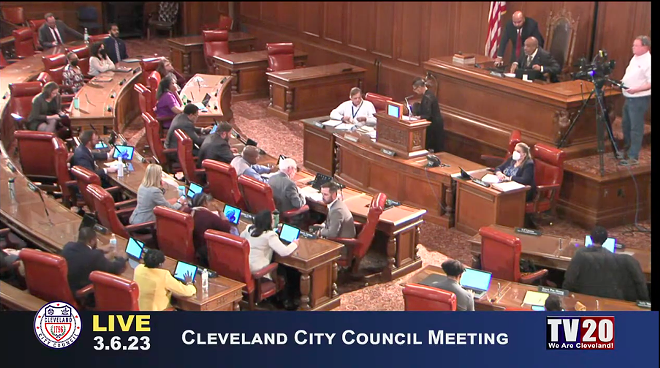
TV20
Council President Blaine Griffin announces two ordinances related to the city's community benefit agreement on Monday.
Months after Council President Blaine Griffin vowed to codify the city's 13-year-old community benefit agreement memo, on Monday he and Jasmin Santana introduced two ordinances that would do just that.
The two ordinances, 297-2023 and 298-2023, would form what Griffin is calling a "legally enforceable agreement" between Cleveland and the contractors involved with projects with city buy-ins over $250,000. Such a deal comes with financial perks for developers, but upside for the city as well.
"All projects will be required to establish a plan to meet minority business enterprise, female business enterprise and Cleveland area small business goals," read a press release describing the first of two ordinances, "as well as resident and low-income resident employment goals."
For Griffin, who's long boosted Black construction in his own Ward 6 since his election in 2017, the feelings of long-time-coming reverberated around Council Chambers Monday, where the Griffin commemorated the legislation he's backed for years.
"I believe this is one of the most important ordinances, as we outline diversity, equity and inclusion as a priority for this council," he said from the president's lectern Monday. "Now we have an ordinance in place to ensure diversity, equity and inclusion on the front end of small and big projects."
Such a movement, Griffin added, is "a defining piece of our four years in council."
Requirements for projects receiving at least $250,000 in city money would include not only delineations on workforce diversity but also apprenticeship programs, mentoring, regular meetings with stakeholders and quarterly reports.
Since former Mayor Frank Jackson announced the memo for a citywide community benefit agreement at City Hall in 2013, big league developers and growing contractors have used Jackson's hiring quotas as a voluntary guide.
Of developer hires, the memo suggested, at least 15 percent should be minorities, seven percent female, and eight percent small businesses. As for city projects, 20 percent of the workforce should be Clevelanders.
Large projects, such as publicly funded renovations of the basketball arena and baseball stadium, followed.
Progressive Field, in its upcoming $205-million upgrade of the ballpark, is purportedly sourcing 20 percent Black construction help in contracts awarded, along with 18 percent small business and eight percent female-owned.
And in April 2019, the Gateway Economic Development Corporation announced that Whiting-Turner's 1,600 workers on the Rocket Mortgage FieldHouse transformation exceeded the city's CBA, with 4 percent more Cleveland hires and nine percent more minority hires than suggested.
In the ordinances introduced Monday—which included technical input from Jennifer O'Leary and Rachel Scalish, Griffin's legal counsel—the same public monitoring seen on Sherwin William's HQ build or Progressive Field's renovation would become a city norm if they are passed.
And, "For large development projects over $20 million, developers will work from a 'menu' of additional community benefits they can provide or establish, as well as provide other benefits based on community input," a councilperson spokesperson said in a press release. “'What’s enough' will be determined by the department director in consultation with the developer by using a scorecard evaluation, and Cleveland Citywide Development Corporation recommendations informed by the community and departments."
The Office of Equal Opportunity will, the city said, host a "public-facing data dashboard" to depict the exact breakdown of hires on ongoing development.
In Griffin's mind, the CBA dashboard—or whatever it shall be called this spring, after legislation is passed—will tell taxpayers who exactly is getting their public dollars.
It's "ensuring Cleveland’s residents receive a return on their investment from development projects and clearly define expectations for them as we build" the city, Griffin told Scene.
Coming soon: Cleveland Scene Daily newsletter. We’ll send you a handful of interesting Cleveland stories every morning. Subscribe now to not miss a thing.
Follow us: Google News | NewsBreak | Instagram | Facebook | Twitter

